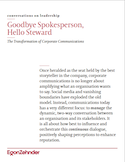The Transformation of Corporate Communications
Once heralded as the seat held by the best storyteller in the company, corporate communications is no longer about amplifying what an organisation wants to say. Social media and vanishing boundaries have exploded the old model. Instead, communications today has a very different focus: to manage the dynamic, two-way conversation between an organisation and its stakeholders. It is all about how best to influence and orchestrate this continuous dialogue, positively shaping perceptions to enhance reputation.
Every fresh corporate crisis reinforces this point. Not long ago the World Economic Forum estimated that 25% of a company’s market value was directly attributable to the strength of its reputation; reputation being its principal intangible asset. Almost 90% of business leaders surveyed by Deloitte rate reputational risk as more significant than any other type of risk.
The skills required in the new environment are far from simple. Reputation management mandates a leader be proactive, carefully evaluating how each business decision will be received and perceived across the stakeholder landscape.
At the same time, best-in-class companies can no longer afford to manage the stakeholder landscape through distinct engagement efforts. Reputation management today requires a fully integrated communications approach, with a consistent strategy across all communication channels cutting across public affairs, media relations, brand marketing, internal communications, financial communications and other formerly disparate strands within the function. Articulating the values of an organisation and standing by them have become part of the “licence to operate” for many companies, so setting corporate social responsibility at the fore of business strategy is also central to the organisation’s future success.
These changes have catalysed a fundamental shift in the corporate affairs function. Executives are evolving from world-class operators to strategic reputation stewards. Many CEOs rely on their Heads of Communication as their “trusted advisor”. Boards and Executive Committees increasingly value the honest insight of credible and experienced Corporate Affairs leaders.
The successful Corporate Affairs leader of the future will not only be called into the room once a decision has been made, and be expected to communicate it to a wider audience, but she/he will be there from the outset to inform on decisions and shape direction. Much like the CFO holds up the numbers to serve as the conscience of the company, the Corporate Affairs Director needs to envision and articulate outside perspectives.
The increasing importance of the role this function plays is reflected in the elevation of the Corporate Affairs leader to the Executive Committee: Eli Lilly, Diageo, Pfizer, Walmart, PepsiCo, Hilton and Vodafone are just some examples of international organisations where the Head of Corporate Affairs has a seat at the top table. In the FTSE 100, up to 75% of the Corporate Affairs Directors report to the CEO, and half of them sit on the Executive Committee. This will continue to evolve in this market and others. As the profile of the most senior executive overseeing corporate affairs continues to grow, so will his or her indispensability at the top table.
These changes are having a major impact on the development of future leadership talent. A successful career focused solely on media relations or public affairs will no longer ready a corporate affairs professional for the top role. Instead they will need to have had experience across the full integrated communications landscape and have practised pulling different levers to add value to the business by elevating its reputation.
So from where will the future talent come for communications leaders? Progressive companies are restructuring the function so that the “no. 2” roles in corporate affairs possess the full mandate across a business line or geographic region. This not only allows reputation management to be handled more tightly and consistently, but it also creates a very natural succession pipeline for a role that will increasingly become part of the Executive Committee.
But how to spot the rising talent to put into these “no. 2” roles? In addition to assessing the specific technical competencies, it is critical to assess these future leaders for potential like other top roles – tomorrow’s leaders will display boundless curiosity and determination and the ability to derive insight from disparate sources of information. And they will need to engage a significantly diverse group of people along the way with authenticity.
Another idea gaining traction is rotating “stars” from other functions/parts of the organisation into corporate affairs for a couple of years, then returning them to line roles, especially in local markets. A rotating development slot in the corporate communications function where high potentials spend some time, often at the corporate centre, will help them get exposure to the full CEO agenda and also fast-track their knowledge about multiple stakeholder management. In fact, the function is a fantastic training ground for a CEO in the making – as today’s CEOs need to fulfil the duties of ambassadors in full public view.
Indeed, no longer a mouthpiece, the new Corporate Affairs Director is the most exciting, multifaceted profile to emerge within the C-suite in a long time, and getting the right leader in that seat has never been more critical.






